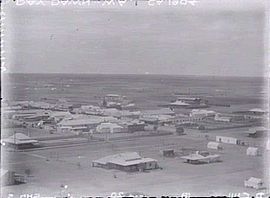- Day Dawn, Western Australia
-
Day Dawn
Western Australia
Day Dawn in 1904.Population: abandoned Established: 1894 Coordinates: 27°17′S 117°31′E / 27.28°S 117.52°ECoordinates: 27°17′S 117°31′E / 27.28°S 117.52°E LGA: Shire of Cue State District: North West Federal Division: Durack Day Dawn was a significant mining town and mine in the Mid West/upper Murchison region of Western Australia just south of Cue in the late nineteenth century.[1] Rich gold deposits were discovered there in 1891 by Ned Heffernan, who pegged out what became known as the 'Day Dawn Reef'.[2]
Originally the settlement was informally called Four Mile, that being its distance from the town of Cue. It was gazetted as the town of Bundawadra on 2 March 1894,[3] renamed Day Dawn on 25 May 1894 and proclaimed a municipality on 24 May 1895.[4]
The state railway network arrived at Cue from Mullewa, a distance of 197 miles, in 1894. Great Fingall Consolidated Gold Mining Company operated the mine from 1898 until 1918, when it was closed. By October 1921, shorings at the abandoned mine, which had been known as the 'Great Fingall mine', had collapsed and the town had disappeared altogether by the 1930s. All of the town's buildings are now in ruins with the exception of the Great Fingall Mine Office, which is on state and federal heritage registers.
An important strike was staged there for nine weeks in 1899 when local miners protested against the use of Italian immigrant contract workers and Great Fingall's attempt to reduce miners' wages by five shillings per week.[3][5][6]
Various mining companies have operated the mine from the early 1990s using the open cut method and by reprocessing the tailings from past activities at the Big Bell gold processing plant. The last owners, Harmony Mining, have recently halted production and have sold the mine to Monarch Gold along with the Big Bell Mine and the Hill 50 Gold Mine at Mount Magnet. Monarch however was never able to pay off the mine and went into administration, returning Hill 50 to Harmony.
References
- ^ "Great Fingall Mine Office". The National Trust of Australia (WA). Archived from the original on 2007-07-16. http://web.archive.org/web/20070716045903/http://www.heritagewa.org.au/places/fingall/. Retrieved 2007-08-22.
- ^ History of country town names - D Landgate website, accessed: 25 January 2010
- ^ a b Kimberly, W.B. (compiler) (1897). History of West Australia. A Narrative of her Past. Together With Biographies of Her Leading Men. Melbourne: F.W. Niven. p. 320
- ^ "Great Fingall Mine Office". Heritage Council of Western Australia. http://register.heritage.wa.gov.au/PDF_Files/G%20-%20A-D/Great%20Fingall%20MineOff(I-AD).PDF. Retrieved 2007-08-22.
- ^ Barry Strickland (October 2005). "More tales of the Golden Age: Danger Down Below". http://www.qfest.com/MoreTalesoftheGoldenAge.htm. Retrieved 2007-08-22.[dead link]
- ^ "THE MINERS' STRIKE AT DAY DAWN.". The West Australian (Perth, WA : 1879-1954) (Perth, WA: National Library of Australia): p. 2. 28 August 1899. http://nla.gov.au/nla.news-article3233757. Retrieved 14 April 2011.
Further reading
- Descriptions of the town and early mines including Day Dawn Mine. The West Australian, 9 February 1893, p. 3; 21 February 1893, p. 6; 31 May 1894, p. 6; 24 August 1894, p. 3; 18 January 1895, p. 7
Towns in the Mid West region of Western Australia Abbotts · Ajana · Alma · Arrino · Arrowsmith · Austin · Big Bell · Binnu · Boogardie · Bowgada · Bunjil · Canna · Cape Burney · Carnamah · Caron · Coorow · Cuddingwarra · Cue · Day Dawn · Dongara · Drummond Cove · East Bowes · Eneabba · Eradu · Gabanintha · Green Head · Greenough · Gunyidi · Gutha · Horseshoe · Horrocks · Howatharra · Isseka · Kalbarri · Kojarena · Koolanooka · Kumarina · Latham · Leeman · Lennonville · Lynton · Mainland · Marchagee · Maya · Meekatharra · Merkanooka · Mingenew · Minnenooka · Moonyoonooka · Morawa · Mount Erin · Mount Magnet · Mullewa · Nabawa · Nangetty · Nannine · Nanson · Naraling · Narngulu · Narra Tarra · Northampton · Oakajee · Ogilvie · Paynes Find · Peak Hill · Paynesville · Perenjori · Pindar · Pintharuka · Porlell · Port Denison · Port Gregory · Protheroe · Reedy · Rothsay · Sandstone · Tardun · Tenindewa · Three Springs · Tuckanarra · Waggrakine · Walkaway · Warriedar · Whelarra · Wicherina · Wiluna · Winchester · Yalgoo · Yandanooka · Youanmi · Yoweragabbie · Yuna

This Australian ghost town-related article is a stub. You can help Wikipedia by expanding it.

